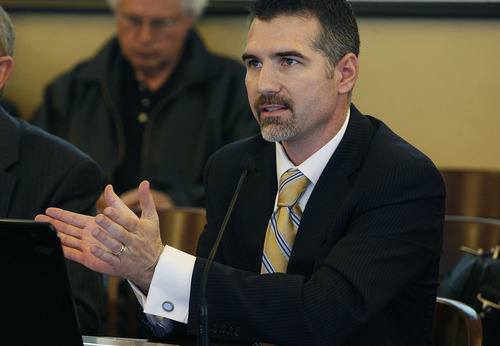This is an archived article that was published on sltrib.com in 2013, and information in the article may be outdated. It is provided only for personal research purposes and may not be reprinted.
Price • The company proposing to build Utah's first commercial nuclear power plant near Green River has spent $17.5 million in the six years since it unveiled plans for a 3,000-megawatt station, according to trial testimony Monday over water the project's needs.
All but about $1 million has come from the operating profit of an oil-and-gas-services company Blue Castle Holdings acquired three years ago in exchange for an equity stake in the project, according to Blue Castle CEO Aaron Tilton, a former Republican lawmaker.
Willow Creek LLC, based in Grand Junction, Colo., builds, replaces and repairs natural gas and crude oil pipelines and storage facilities in Utah and four other states. It earns $7 million to $8 million off annual revenues of $30 million, Tilton said. He added that he intends to use this profit in the federal licensing process, expected to cost $100 million, and approach potential investors to make up the difference.
The information is crucial to Blue Castle's claims that it possesses the financial means to put the requested 53,000 acre feet to "beneficial use," one of the findings necessary for a water right under the doctrine of prior appropriation.
Tilton's testimony drew skepticism from the environmentalists suing to block the project. HEAL Utah policy director Matt Pacenza questioned why the owners of a company as profitable as Willow Creek would trade it for a stake in an enterprise that might not produce revenue for years, if ever.
"Best-case scenario is they are $40 [million] to $50 million short of what they need and that's just to apply to the [Nuclear Regulatory Commission]," Pacenza said. Building the plant will cost between $16 billion and $18 billion.
Along with other groups and local business, HEAL has taken Blue Castle to court seeking to invalidate the rights State Engineer Kent Jones transferred last year from a failed coal-fired plant. The nuclear plant would use the water, enough to supply a medium-size Utah city, to cool its two reactors.
A week of testimony and arguments will unfold in the courtroom of 7th District Judge George Harmond, who hopes to wrap up the trial by Friday, although a ruling will not likely come right away.
Harmond is hearing Blue Castle's witnesses first and will hear from opponents' experts later in the week.
In their lawsuit, environmentalists contend Jones failed to exercise required due diligence last year when he assigned rights held by San Juan and Kane counties to Blue Castle. The environmental groups say a healthy Green River might not be able to sustain such a large diversion and Blue Castle has yet to demonstrate a market for the power it hopes to start generating by 2024.
HEAL's lawyer John Flitton pressed Tilton on which utilities have expressed an interest in purchasing the plant's prodigious electrical output. Tilton dropped the name of Rocky Mountain Power, which listed Blue Castle as a possible power source in its long-range planning documents. He conceded such listings do not reflect a commitment to actually buy any power.
Despite diminishing flows on the Green River, former State Engineer Jerry Olds, now part of the Blue Castle team, testified that there will be plenty of water to operate a nuclear power plant safely in Emery County for the next half century.
Blue Castle's chief operating officer Tom Retson said the firm has conducted half the work needed to get an early-site permit from the NRC, a process it can pull off even if it fails to attract new investors. The federal agency already has visited the project site west of Green River three times and has assembled project teams in anticipation of receiving Blue Castle's application.
Around the world, 71 nuclear plants are under construction and at least 14 proposed plants are in the licensure pipeline in the United States, Retson said. Blue Castle is following a well-trod path and has the expertise to negotiate regulatory hurdles in a cost-effective way. Its principals include former NRC chair Nils Diaz and Reed Searle, former general manager of the Intermountain Power Agency.
While no power-purchase agreements have been signed, Retson said he expects regional utilities, which currently have little access to nuclear power, will eventually want to own a piece of Blue Castle.



